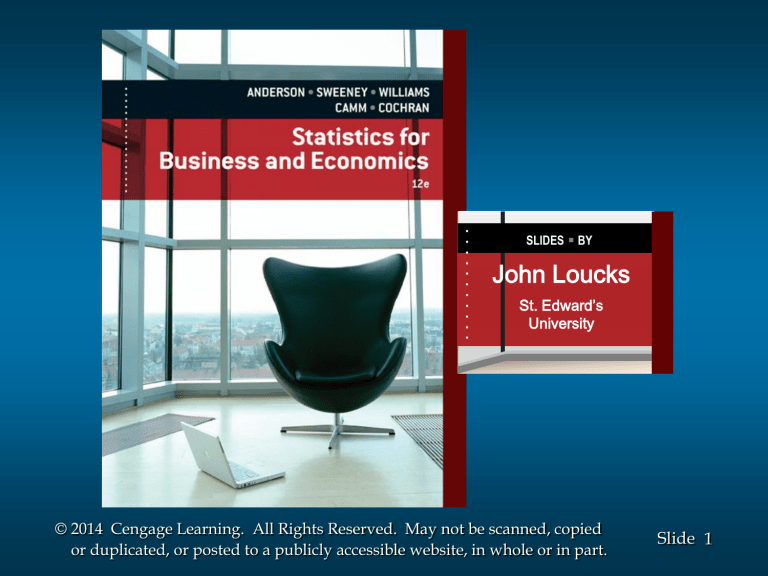
.. . .. . .. . .. SLIDES . BY John Loucks St. Edward’s University © 2014 Cengage Learning. All Rights Reserved. May not be scanned, copied or duplicated, or posted to a publicly accessible website, in whole or in part. Slide 1 An Introduction to Experimental Design and Analysis of Variance In this chapter three types of experimental designs are introduced. • • • a completely randomized design a randomized block design a factorial experiment © 2014 Cengage Learning. All Rights Reserved. May not be scanned, copied or duplicated, or posted to a publicly accessible website, in whole or in part. Slide 2 An Introduction to Experimental Design and Analysis of Variance A factor is a variable that the experimenter has selected for investigation. A treatment is a level of a factor. Experimental units are the objects of interest in the experiment. A completely randomized design is an experimental design in which the treatments are randomly assigned to the experimental units. © 2014 Cengage Learning. All Rights Reserved. May not be scanned, copied or duplicated, or posted to a publicly accessible website, in whole or in part. Slide 3 Analysis of Variance: A Conceptual Overview Analysis of Variance (ANOVA) can be used to test for the equality of three or more population means. Data obtained from observational or experimental studies can be used for the analysis. We want to use the sample results to test the following hypotheses: H0: 1 = 2 = 3 = . . . = k Ha: Not all population means are equal © 2014 Cengage Learning. All Rights Reserved. May not be scanned, copied or duplicated, or posted to a publicly accessible website, in whole or in part. Slide 4 Analysis of Variance: A Conceptual Overview H0: 1 = 2 = 3 = . . . = k Ha: Not all population means are equal If H0 is rejected, we cannot conclude that all population means are different. Rejecting H0 means that at least two population means have different values. © 2014 Cengage Learning. All Rights Reserved. May not be scanned, copied or duplicated, or posted to a publicly accessible website, in whole or in part. Slide 5 Analysis of Variance: A Conceptual Overview Assumptions for Analysis of Variance For each population, the response (dependent) variable is normally distributed. The variance of the response variable, denoted 2, is the same for all of the populations. The observations must be independent. © 2014 Cengage Learning. All Rights Reserved. May not be scanned, copied or duplicated, or posted to a publicly accessible website, in whole or in part. Slide 6 Analysis of Variance: A Conceptual Overview Sampling Distribution of x Given H0 is True Sample means are close together because there is only one sampling distribution when H0 is true. x2 x2 x1 2 n x3 © 2014 Cengage Learning. All Rights Reserved. May not be scanned, copied or duplicated, or posted to a publicly accessible website, in whole or in part. Slide 7 Analysis of Variance: A Conceptual Overview Sampling Distribution of x Given H0 is False Sample means come from different sampling distributions and are not as close together when H0 is false. x3 3 x1 1 2 x2 © 2014 Cengage Learning. All Rights Reserved. May not be scanned, copied or duplicated, or posted to a publicly accessible website, in whole or in part. Slide 8 Analysis of Variance and the Completely Randomized Design Between-Treatments Estimate of Population Variance Within-Treatments Estimate of Population Variance Comparing the Variance Estimates: The F Test ANOVA Table © 2014 Cengage Learning. All Rights Reserved. May not be scanned, copied or duplicated, or posted to a publicly accessible website, in whole or in part. Slide 9 Between-Treatments Estimate of Population Variance 2 The estimate of 2 based on the variation of the sample means is called the mean square due to treatments and is denoted by MSTR. k MSTR 2 n ( x x ) j j Denominator is the degrees of freedom associated with SSTR j 1 k1 Numerator is called the sum of squares due to treatments (SSTR) © 2014 Cengage Learning. All Rights Reserved. May not be scanned, copied or duplicated, or posted to a publicly accessible website, in whole or in part. Slide 10 Within-Treatments Estimate of Population Variance 2 The estimate of 2 based on the variation of the sample observations within each sample is called the mean square error and is denoted by MSE. k MSE Denominator is the degrees of freedom associated with SSE 2 (n j 1) s 2j j1 nT k Numerator is called the sum of squares due to error (SSE) © 2014 Cengage Learning. All Rights Reserved. May not be scanned, copied or duplicated, or posted to a publicly accessible website, in whole or in part. Slide 11 Comparing the Variance Estimates: The F Test If the null hypothesis is true and the ANOVA assumptions are valid, the sampling distribution of MSTR/MSE is an F distribution with MSTR d.f. equal to k - 1 and MSE d.f. equal to nT - k. If the means of the k populations are not equal, the value of MSTR/MSE will be inflated because MSTR overestimates 2. Hence, we will reject H0 if the resulting value of MSTR/MSE appears to be too large to have been selected at random from the appropriate F distribution. © 2014 Cengage Learning. All Rights Reserved. May not be scanned, copied or duplicated, or posted to a publicly accessible website, in whole or in part. Slide 12 Comparing the Variance Estimates: The F Test Sampling Distribution of MSTR/MSE Sampling Distribution of MSTR/MSE Reject H0 Do Not Reject H0 F Critical Value MSTR/MSE © 2014 Cengage Learning. All Rights Reserved. May not be scanned, copied or duplicated, or posted to a publicly accessible website, in whole or in part. Slide 13 ANOVA Table for a Completely Randomized Design Source of Variation Sum of Degrees of Squares Freedom SSTR k-1 Error SSE nT - k Total SST nT - 1 Treatments SST is partitioned into SSTR and SSE. Mean Square pValue F SSTR MSTR k-1 MSE SSE MSE nT - k MSTR SST’s degrees of freedom (d.f.) are partitioned into SSTR’s d.f. and SSE’s d.f. © 2014 Cengage Learning. All Rights Reserved. May not be scanned, copied or duplicated, or posted to a publicly accessible website, in whole or in part. Slide 14 ANOVA Table for a Completely Randomized Design SST divided by its degrees of freedom nT – 1 is the overall sample variance that would be obtained if we treated the entire set of observations as one data set. With the entire data set as one sample, the formula for computing the total sum of squares, SST, is: k nj SST ( xij x )2 SSTR SSE j 1 i 1 © 2014 Cengage Learning. All Rights Reserved. May not be scanned, copied or duplicated, or posted to a publicly accessible website, in whole or in part. Slide 15 Test for the Equality of k Population Means Hypotheses H0: 1 = 2 = 3 = . . . = k Ha: Not all population means are equal Test Statistic F = MSTR/MSE © 2014 Cengage Learning. All Rights Reserved. May not be scanned, copied or duplicated, or posted to a publicly accessible website, in whole or in part. Slide 16 Test for the Equality of k Population Means Rejection Rule p-value Approach: Reject H0 if p-value < Critical Value Approach: Reject H0 if F > F where the value of F is based on an F distribution with k - 1 numerator d.f. and nT - k denominator d.f. © 2014 Cengage Learning. All Rights Reserved. May not be scanned, copied or duplicated, or posted to a publicly accessible website, in whole or in part. Slide 17 End of Chapter 13 © 2014 Cengage Learning. All Rights Reserved. May not be scanned, copied or duplicated, or posted to a publicly accessible website, in whole or in part. Slide 18






